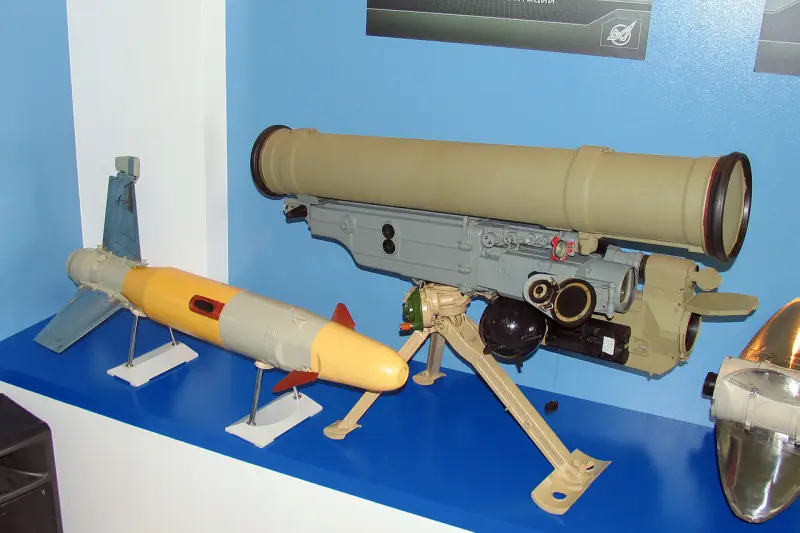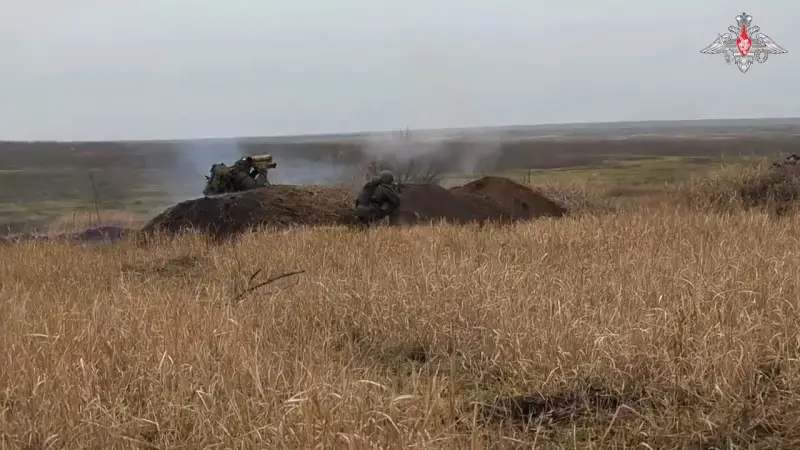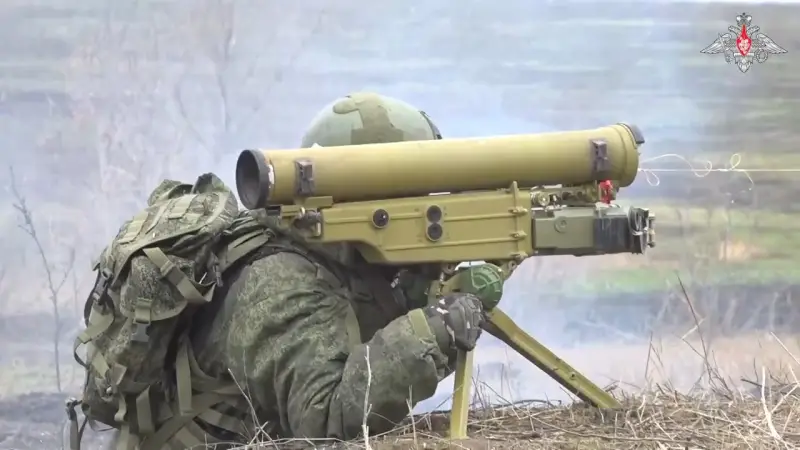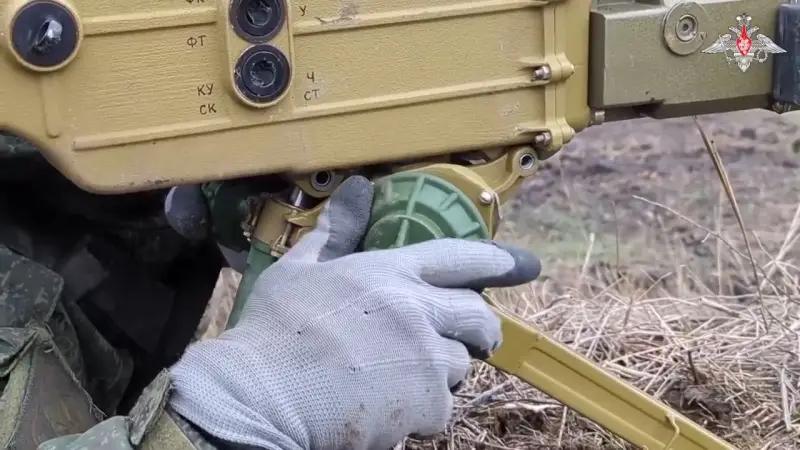ATGM "Metis-M1". Not new, but not outdated

Complex "Metis-M1" at the exhibition
To combat enemy armored vehicles and fortifications during the current Special Operation, Russian infantry is using a variety of anti-tank missile systems. Together with other products of this class, the 9K115-2 Metis-M1 ATGM is used. It cannot be called completely new, but the demonstrated level of tactical and technical characteristics makes it possible to solve basic problems and hit typical targets.
Consistent development
The first version of the 9K115 Metis ATGM with the 9M115 missile was developed by the Tula Instrument Design Bureau in the mid-seventies. In 1978, it was adopted, put into production and began to be used by the troops. The second generation complex was intended to replace older types of weapons and qualitatively strengthen infantry weapons at the company level.
At the turn of the eighties and nineties, Metis underwent modernization, which resulted in the improved ATGM 9K115-1 Metis-M. It included a new 9M131 missile with an increased firing range, a more powerful warhead and other advantages. "Metis-M" was put into service in 1992, but the rearmament process occurred during a difficult period and was delayed.
At the beginning of the 9s, they carried out another modernization and created the 115K2-1 Metis-M2004 ATGM. In 1, this product was introduced to the international market and was the subject of several orders. Serial “Metis-M9” were delivered to Algeria, Syria and other countries. At the same time, the Russian army, for a number of reasons, continued to order and use older versions of the 115KXNUMX ATGM.

ATGM crew involved in the Special Operation
Only in 2015 was it decided to switch to the latest modification of Metis. The order to accept the 9K115-2 product for service appeared in the spring of 2016. Serial production had already been established at the KBP, and in a short time the army was able to obtain the desired complexes of the new model. Apparently, Metis-M1s are still being produced and are actively being supplied to the troops.
Complex at the front
Since 2016, the Ministry of Defense has repeatedly demonstrated various training events with the participation of Metis-M1 ATGM crews. The soldiers practiced the process of detecting an armored target, and also launched missiles and hit targets simulating Tanks enemy. In the conditions of the training grounds, high efficiency was achieved, due to the perfection of technology and the training of personnel.
From the very beginning of the Special Operation to protect Donbass, the Russian army has been actively using the entire range of available anti-tank systems, including Metis-M1. The Ministry of Defense, the press and thematic blogs have repeatedly demonstrated the use of such weapons against various enemy targets. In open publications, the work of crews can be seen both from the outside and literally through the eyes of the gunner-operator.
It should be noted that the complexes of the 9K115 family, including the newest modification, are inferior to other domestic ATGMs in a number of basic tactical and technical characteristics. At the same time, they have advantages that offset all the disadvantages and allow crews to effectively solve combat missions. It should be remembered that it is not only the technique that matters, but also the skills of the fighters.

The missile is launched (the control wire is visible), the operator accompanies the target
The Metis-M1 product compares favorably with other modern domestic ATGMs in size and weight. The transport and launch container, which determines the overall dimensions of the complex, has a length of less than 1 m; the mass of ammunition in the TPK is less than 14 kg. The starting device with the machine weighs approx. 15 kg. A complex with several missiles is carried by crews using special pack packs. In addition, its dimensions and weight allow it to be transported by any vehicle, as well as installed on such a platform for launching.
The 9K115-2 complex includes unified 9M131 missiles of two modifications with different warheads. The 9M131M product with a tandem shaped charge is designed to work against protected targets. Such a missile penetrates at least 850-900 mm of armor behind dynamic protection. The 9M131F missile is equipped with a thermobaric warhead, the detonation power of which is comparable to medium-caliber artillery shells.
Thus, the Metis-M1 anti-tank missile system is lightweight, easy to operate and maneuverable for hitting a variety of targets. Reportedly, during the Special Operation it is used to successfully destroy armored vehicles of various classes, including main tanks. It also demonstrates the effective destruction of buildings and the destruction of manpower in open areas and in shelters.
Success technologies
The 9K115-2 “Metis-M1” product is a second-generation portable infantry anti-tank missile system capable of hitting stationary and moving targets at distances of up to 2 km at any time of the day and in any weather conditions. The ATGM was initially designed as a wearable system, but its architecture and ergonomics allow it to be used on various self-propelled platforms.

The operator corrects the aiming
To place the complex in position, a 9M151M launcher with a tripod machine, guidance mechanisms and other units is used. The 9S816 guidance device is used, supplemented by the 1PN86BVI “Mulat-115” thermal imaging device. A TPK with a 9M131 missile is installed on top of the control devices. It is possible to use old 9M115 missiles.
The guidance device has optical observation means for detecting and tracking a target. Aiming the aiming mark at the target is carried out by moving the guidance device and the launcher as a whole using manual drives with flywheels. The control device also has means for tracking the position of the rocket in space relative to the line of sight. Based on this data, the electronics generate commands for the rocket.
The 9M115 and 9M131 missiles, despite all their design differences, have the same control system. On board the rocket there is a coil of wire that unwinds in flight and serves to transmit commands from the guidance device. Thanks to this, the rocket only has a pyrotechnic tracking tracer and actuators, which simplifies its design and reduces the cost of production.
The 9M131 series missiles were created as a modern replacement for the 9M115 with an increase in the main flight and combat characteristics by increasing the dimensions and weight. These missiles have an elongated body with a length of 810 mm and a diameter of 130 mm - versus 33 and 93 mm for its predecessor. The starting weight increased to 13 kg. In the rear part of the hull there are stabilizers that can be deployed in flight; one of the planes carries a tracer.

Thermobaric warhead flash; shooting through a thermal imager
The head of the rocket houses part of the control instruments and a steering gear that controls the position of a pair of rudders. The leading warhead charge is also located there. In the center of the rocket are the main warhead charge and a solid propellant engine with side nozzles. The tail compartment is given over to a wire spool and other devices.
Metis-M1 missiles in flight reach speeds of up to 200 m/s and fly at a distance of 80 to 2000 m. The penetration of a cumulative warhead exceeds 850-900 mm, which in theory allows you to hit modern and outdated tanks from any angle. The thermobaric warhead has a mass of approx. 5 kg.
Old but not outdated
Last year marked 45 years since the 9K115 Metis ATGM was adopted by the Soviet Army. The latest modification of this complex, 9K115-2 "Metis-M1", appeared two decades ago, but entered service only in the mid-1s. Thus, all variants of the Metis complex are not new. At the same time, the latest Metis-MXNUMX cannot be called obsolete.
Product 9K115-2 and its individual components have a fairly high level of performance and retain a certain potential. As practice has shown, when used correctly, they effectively solve all expected combat missions and fully realize their technical capabilities. At the same time, depending on the situation and circumstances, the Metis-M1 can be used independently or in conjunction with newer and more advanced anti-tank systems, which can further improve the effectiveness of combat work.
Information